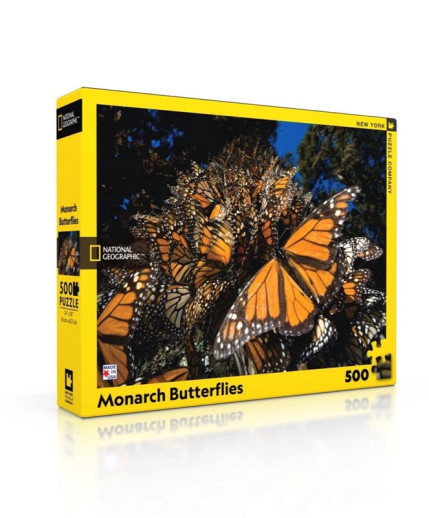We use cookies to make your experience better. To comply with the new e-Privacy directive, we need to ask for your consent to set the cookies. Learn more.
Monarch Butterflies Puzzle (500 piece) National Geographic
Monarch butterflies (Danaus plexippus) are known for the incredible mass migration that brings millions of them to California and Mexico each winter.
North American monarchs are the only butterflies that make such a massive journey—up to 3,000 miles. The insects must begin this journey each fall ahead of cold weather, which will kill them if they tarry too long.
Only monarchs born in late summer or early fall make the migration, and they make only one round trip. By the time next year's winter migration begins, several summer generations will have lived and died and it will be last year's migrators' great grandchildren that make the trip. Yet somehow these new generations know the way and follow the same routes their ancestors took—sometimes even returning to the same tree.
Monarch butterflies begin life as eggs and hatch as larvae that eat their eggshells and, subsequently, the milkweed plants on which they were placed. Monarchs are dependent on milkweed plants, which larvae eat nearly exclusively.
Fattening larvae become juicy, colorful caterpillars, then create a hard protective case around themselves as they enter the pupa stage. They emerge as beautifully colored, black-orange-and-white adults. The colorful pattern makes monarchs easy to identify—and that's the idea. The distinctive pattern warns predators that the insects are foul tasting and poisonous.
Butterflies that emerge from chrysalides (pupa state) in late summer and early fall are different from those that do so during the longer days and warmer weather of summer. The monarchs that emerge later are born to fly, and know because of the changing weather that they must prepare for their lengthy journey.
| Product Format: | Other |
|---|---|
| Brand: | New York Puzzle Company |
| Grades: | 3-AD |
| EAN/UPC: | 819844016135 |
| Length in Inches: | 8.125 |
| Width in Inches: | 10.125 |
| Height in Inches: | 2 |
| Weight in Pounds: | 1.15 |

